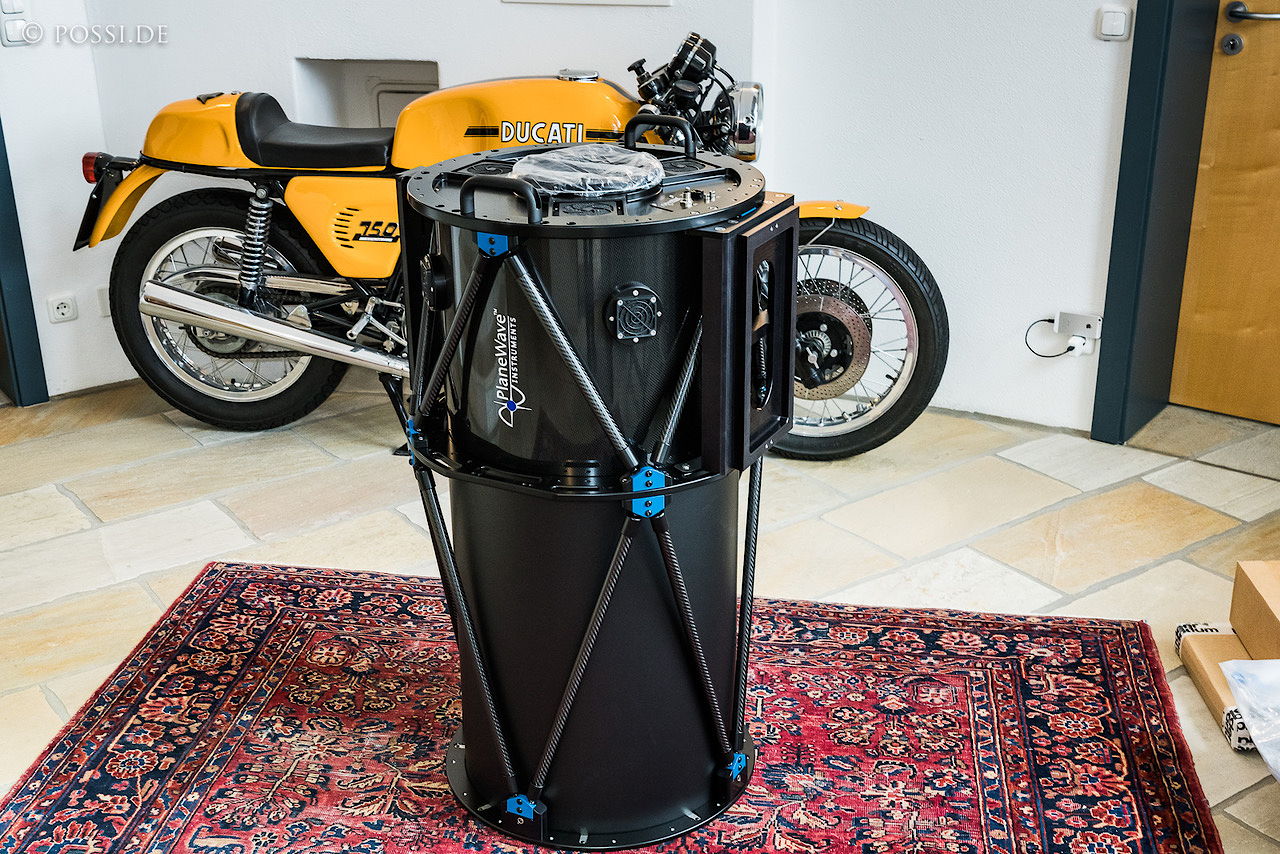 Just arrived in 2021: A great instrument, the Planwave CDK17 with 2939mm focal length at f6.8, with reducer 1965mm at f4.5. Planewave offered a special price for a month. Credits to them!
Just arrived in 2021: A great instrument, the Planwave CDK17 with 2939mm focal length at f6.8, with reducer 1965mm at f4.5. Planewave offered a special price for a month. Credits to them!
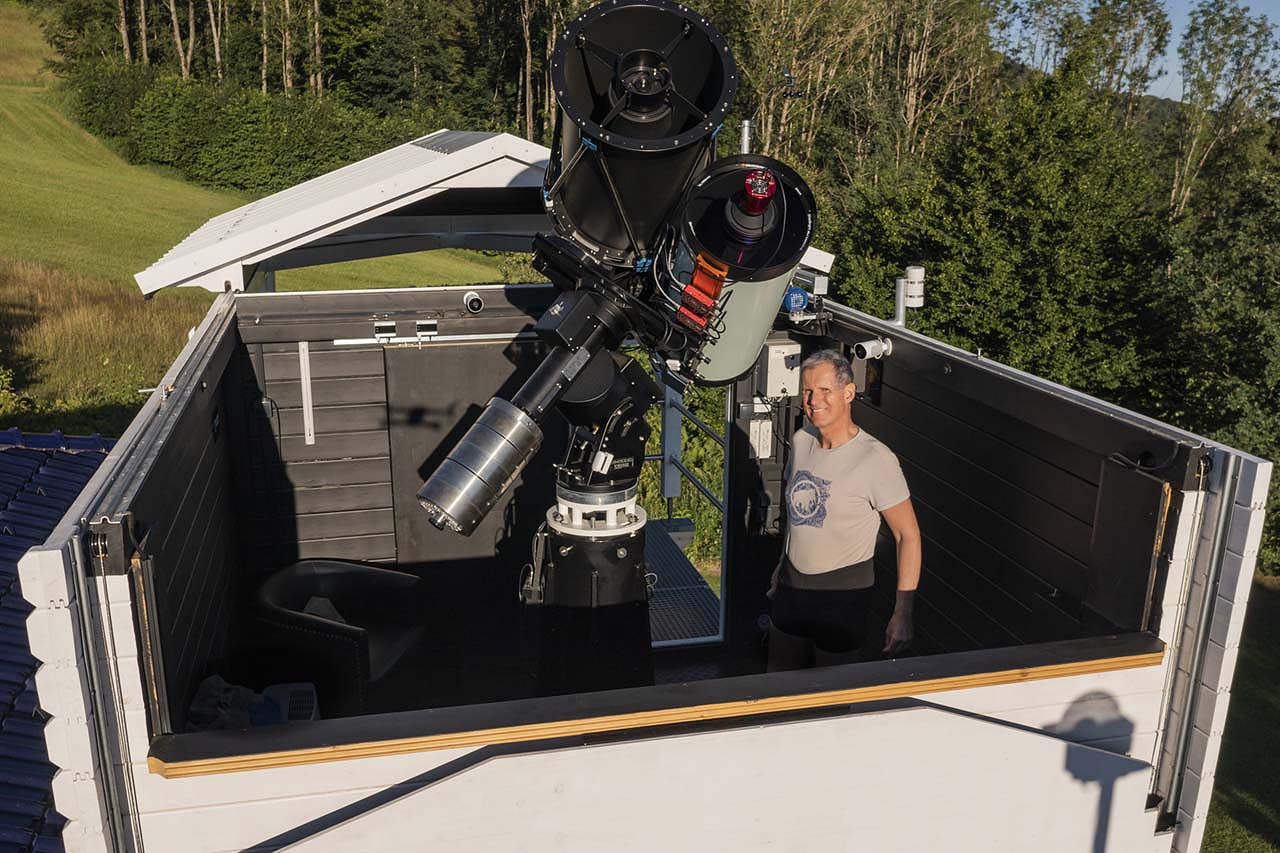 Using a self CNC milled 8" double mounting plate, a Celestron RASA36 was mounted March 2022 next to the CDK for super faint objects.
Using a self CNC milled 8" double mounting plate, a Celestron RASA36 was mounted March 2022 next to the CDK for super faint objects.
Both instruments have their own filters. The CDK17 uses 3nm Chroma narrowband filters with a 7 stop electric filter wheel for LRGBHSO.
The RASA36 uses 6nm blue preshifted Astrodon "max FR" narrowband filters with a manual filter slider. Both instruments use the 61 Mpixel monochrome ZWO ASI6200MM PRO cameras and electrical focusing.
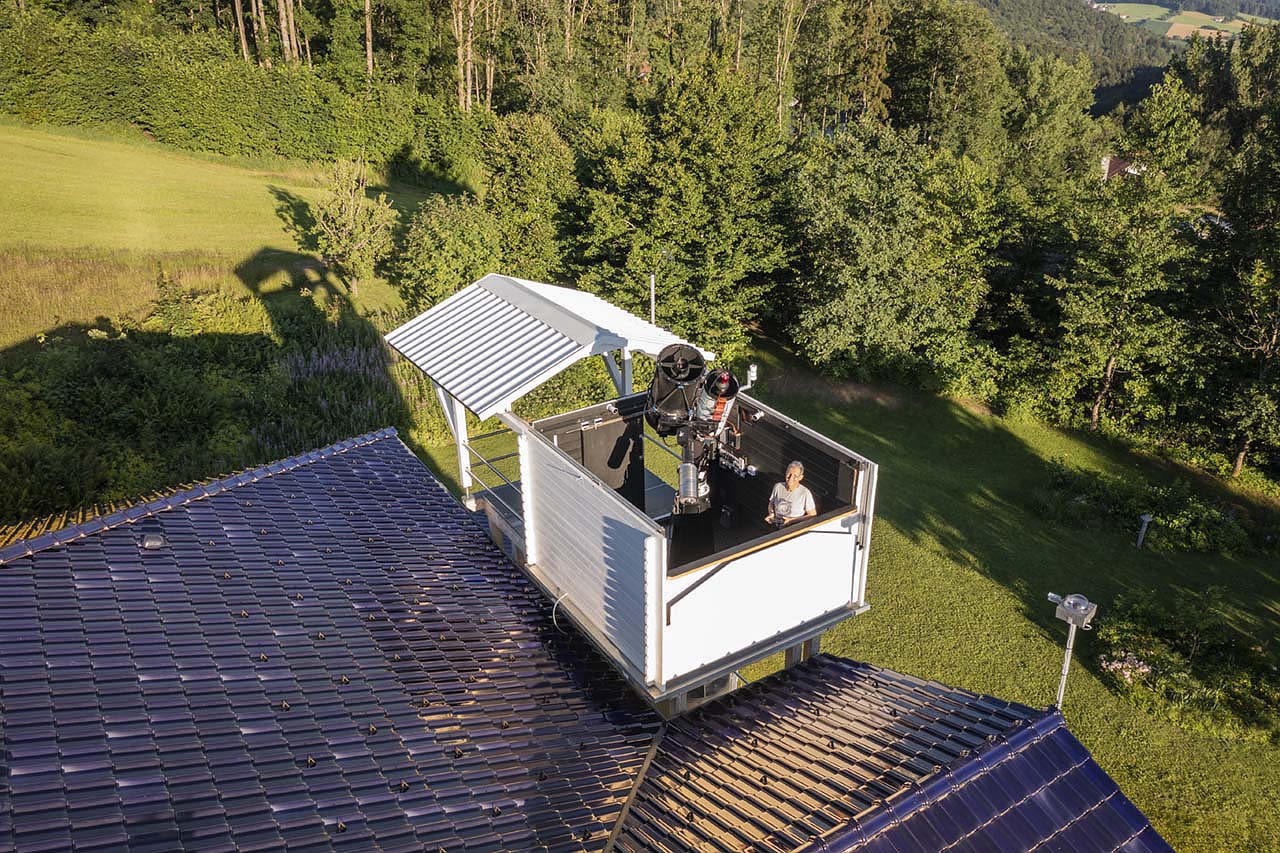 I built the observatory on stilts at the height of the roof, so that the view in all directions is guaranteed and trees do not interfere. Only in the east are objects below 18° height inaccessible because of the hill.
I built the observatory on stilts at the height of the roof, so that the view in all directions is guaranteed and trees do not interfere. Only in the east are objects below 18° height inaccessible because of the hill.
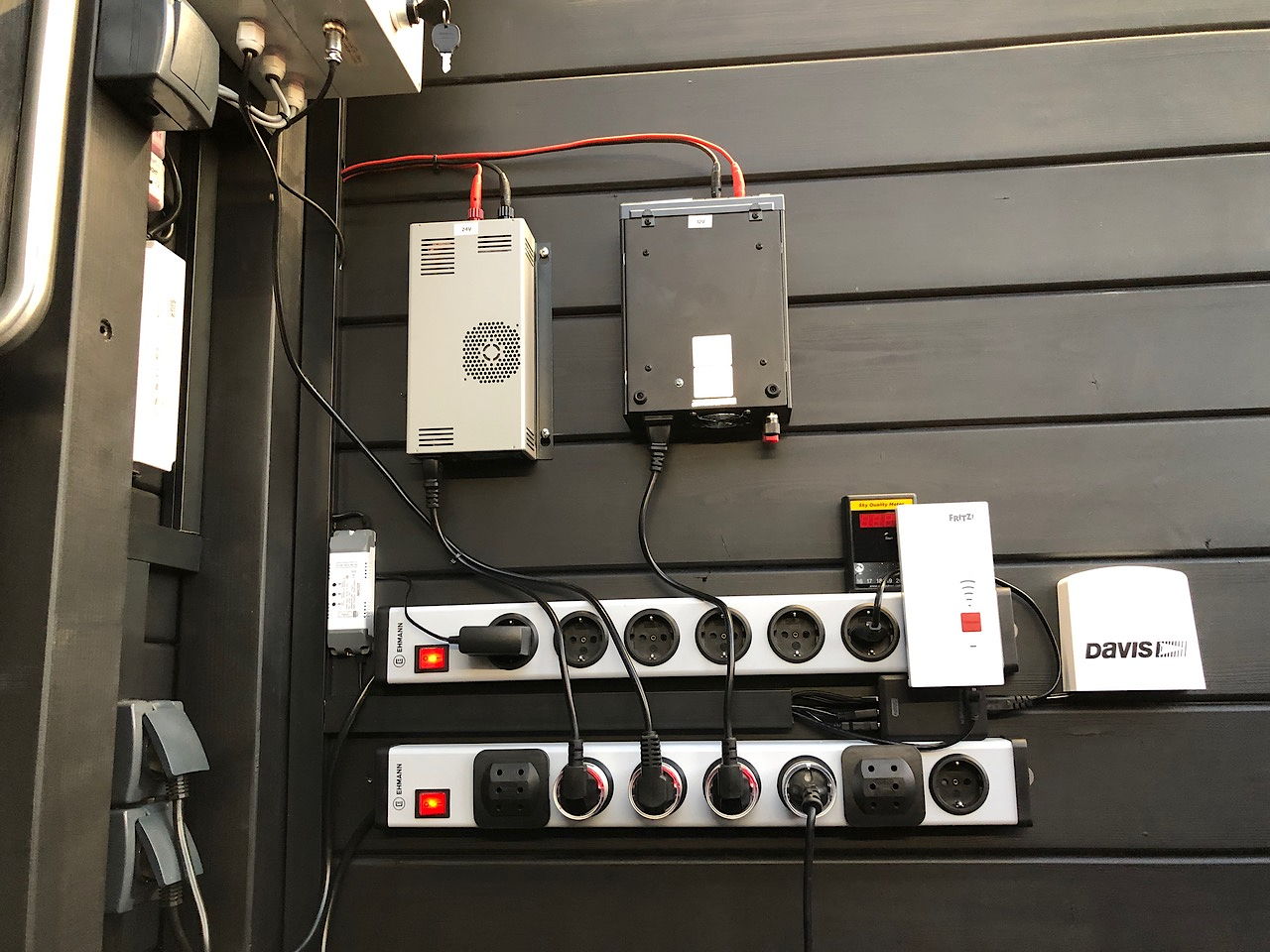 The observatory is painted matte black inside to suppress moon reflections. The electrical installation is completely remote operable.
The observatory is painted matte black inside to suppress moon reflections. The electrical installation is completely remote operable.
Several WIFI controlled smart home components are installed. This allows the remote use of the complete observatory. I actually only go up to the observatory occasionally for maintenance and cleaning.
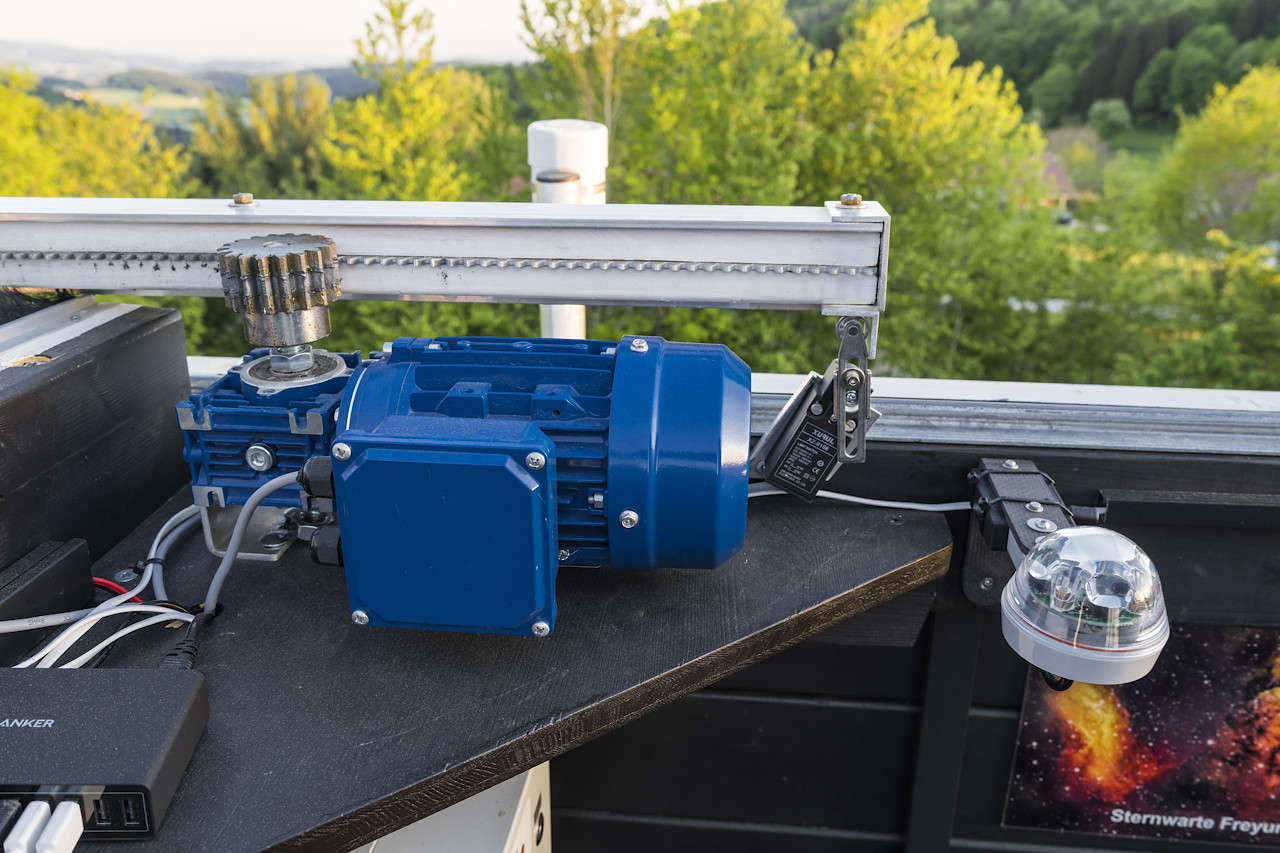 The blue motor opens and closes the roof electrically. In the front right you can see the super sensitive infrared rain sensor, which I coupled to a smart home alarm to my phone.
The blue motor opens and closes the roof electrically. In the front right you can see the super sensitive infrared rain sensor, which I coupled to a smart home alarm to my phone.
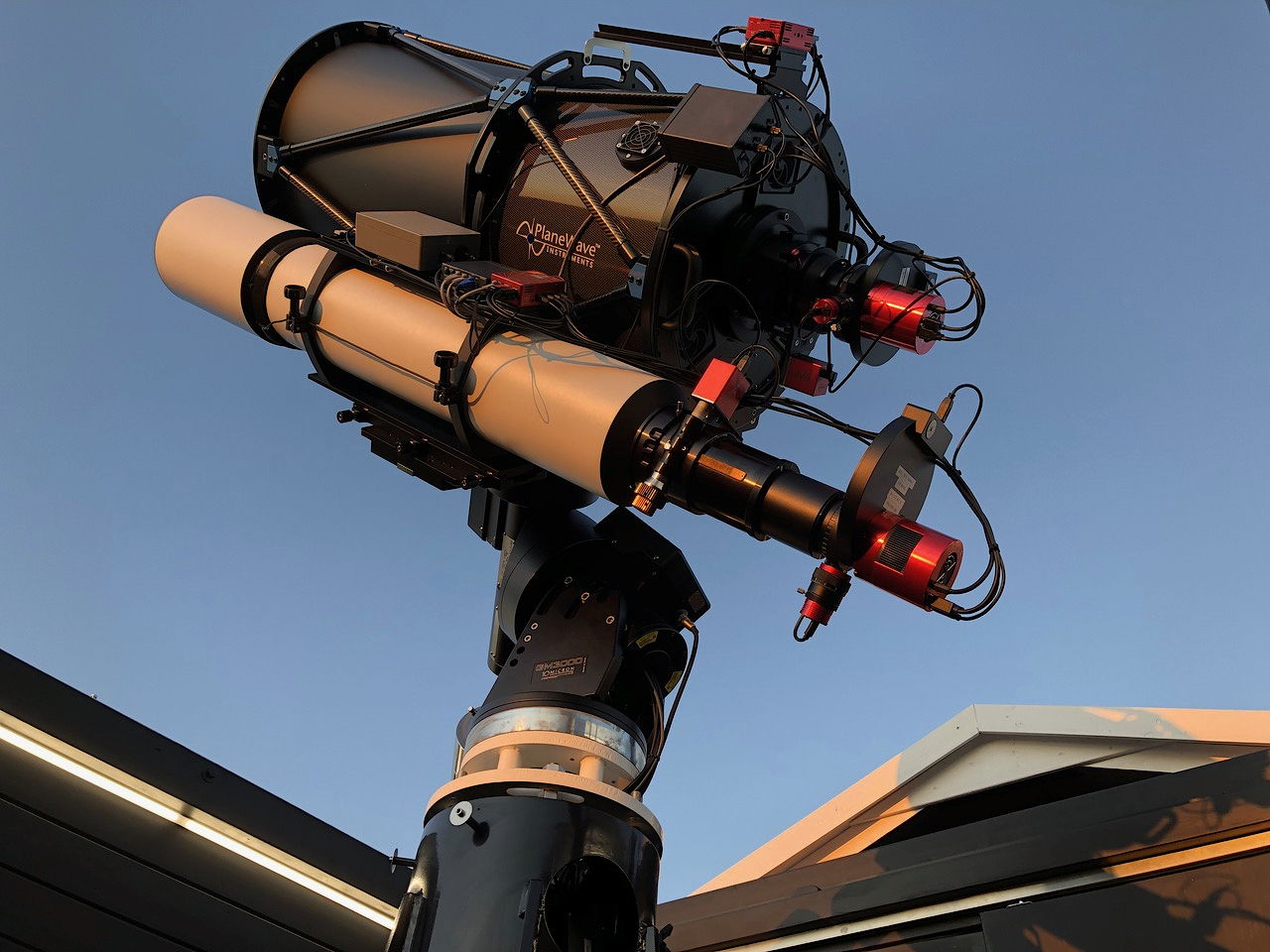 Here the older instrumentation at mid 2021. The CFF185 refractor with reducer has luminous intensity f5.5 at 1015mm focal length. An excellent instrument, I still kept it.
Here the older instrumentation at mid 2021. The CFF185 refractor with reducer has luminous intensity f5.5 at 1015mm focal length. An excellent instrument, I still kept it.
At the front of the mount, a 10Micron GM3000HPS, a precision hair hygrometer for monitoring humidity.
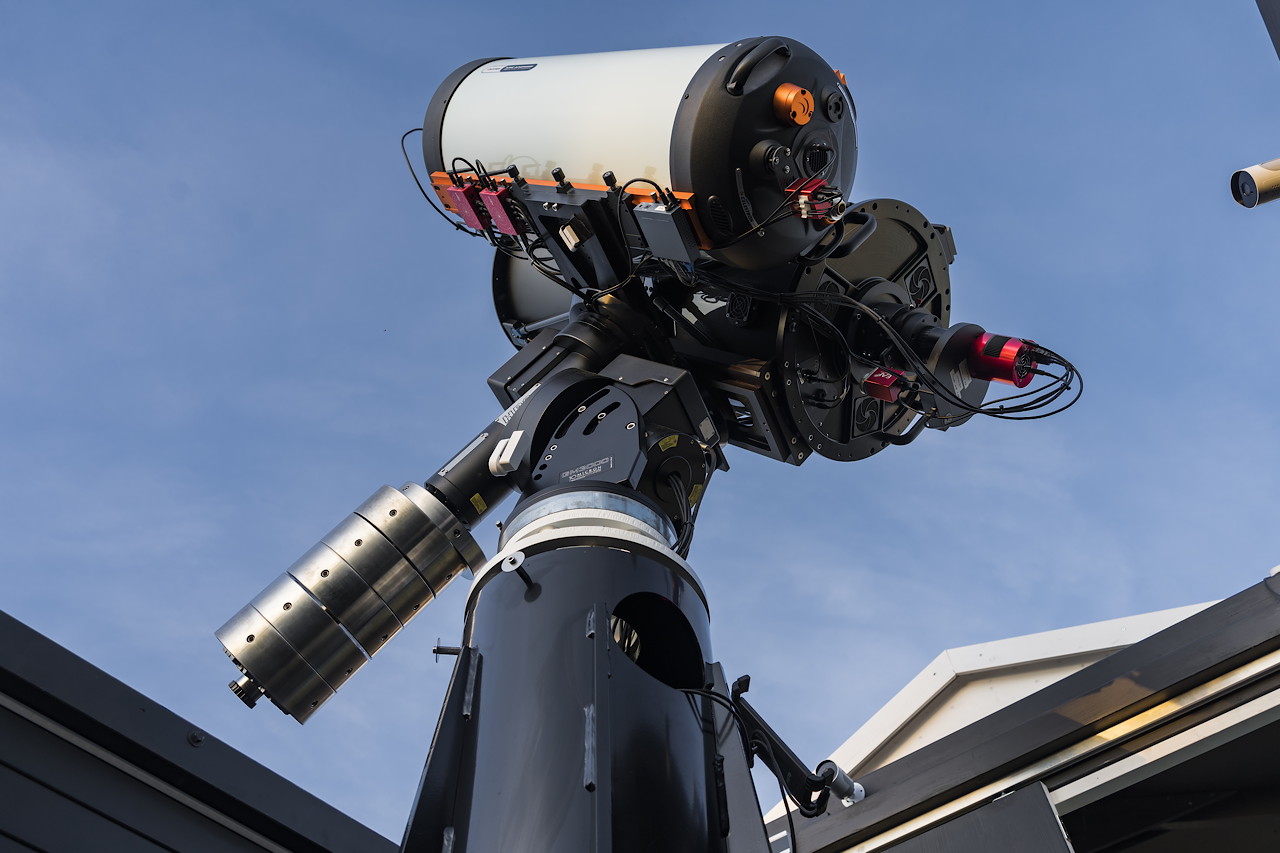 Currently 112kg counterweights are installed. After replacing the CFF185 with the large RASA36, the weight limit of the mount (100kg) has been slightly exceeded, fortunately no problems have occurred as a result.
Currently 112kg counterweights are installed. After replacing the CFF185 with the large RASA36, the weight limit of the mount (100kg) has been slightly exceeded, fortunately no problems have occurred as a result.
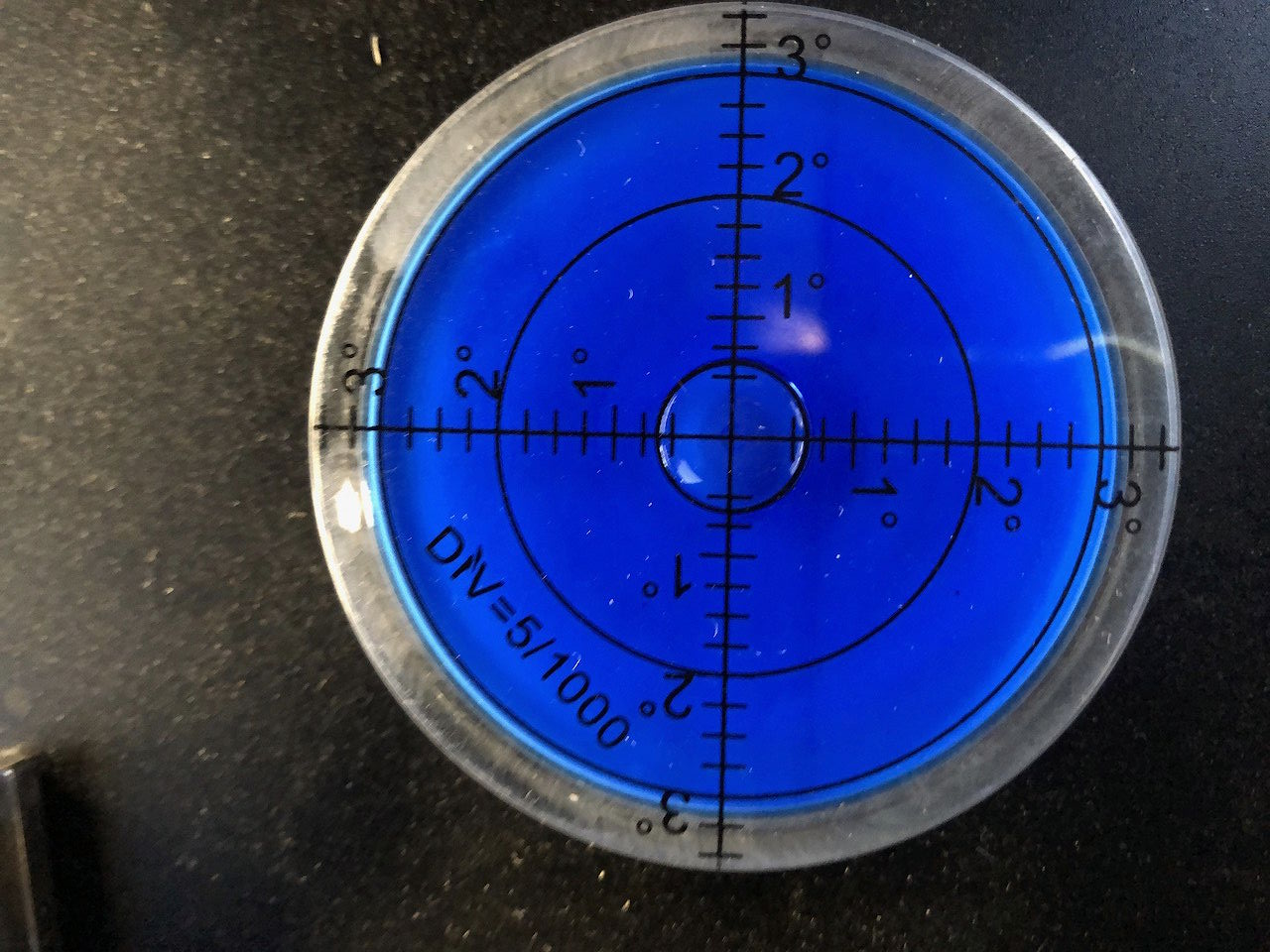 The mount was aligned horizontally and polar-aligned with high precision.
The mount was aligned horizontally and polar-aligned with high precision.
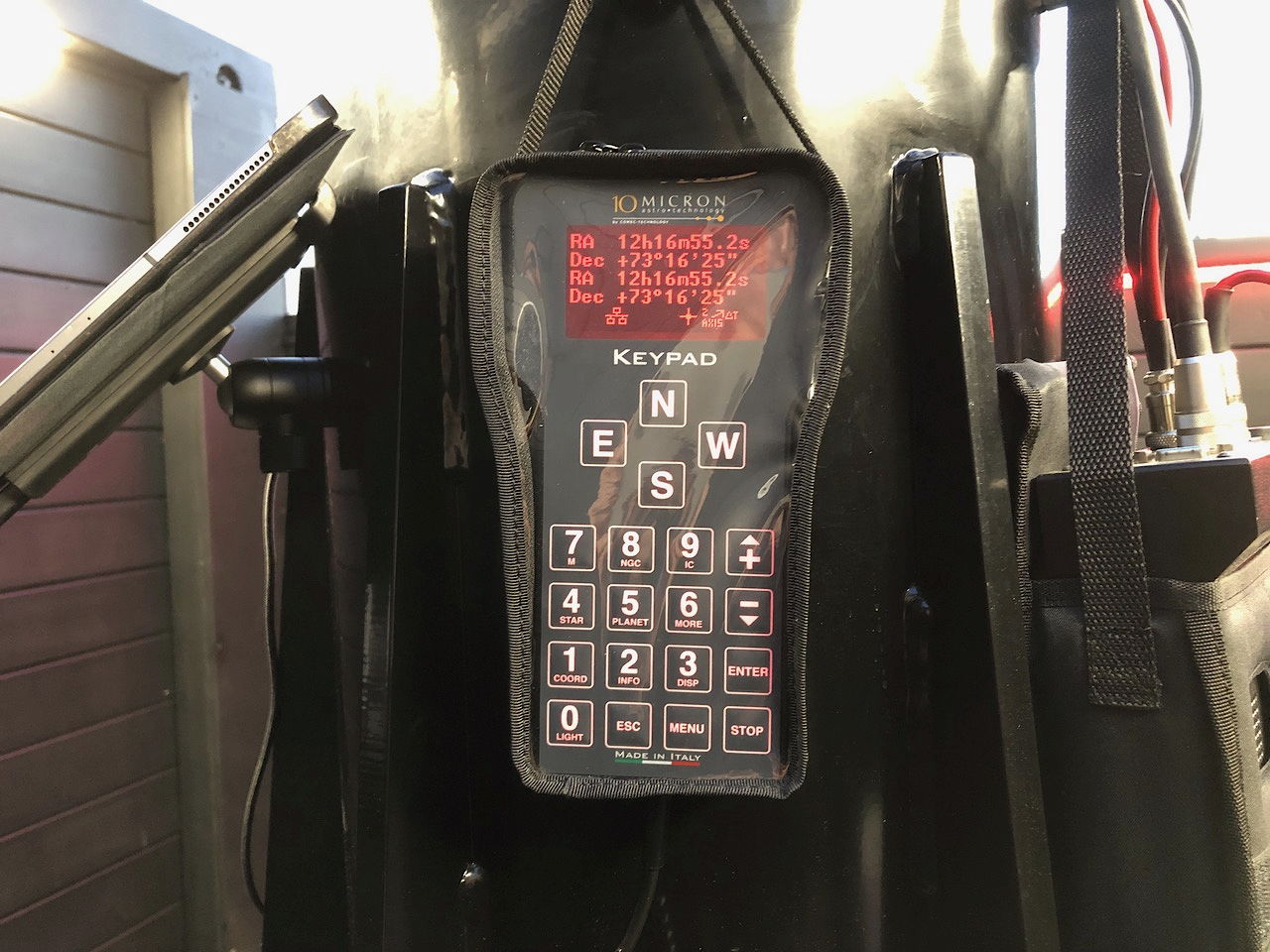 The incredibly elaborately made control panel of the 10Micron mount. Actually totally superfluous, since the operation is exclusively remote.
The incredibly elaborately made control panel of the 10Micron mount. Actually totally superfluous, since the operation is exclusively remote.
 For the iPad, which controls the entire system wirelessly, I have attached a holder here. Mostly, however, I sit comfortably in bed and operate from there. Thanks to a VPN, remote control of the system is also possible from anywhere in the world, which I use regularly on holiday.
For the iPad, which controls the entire system wirelessly, I have attached a holder here. Mostly, however, I sit comfortably in bed and operate from there. Thanks to a VPN, remote control of the system is also possible from anywhere in the world, which I use regularly on holiday.
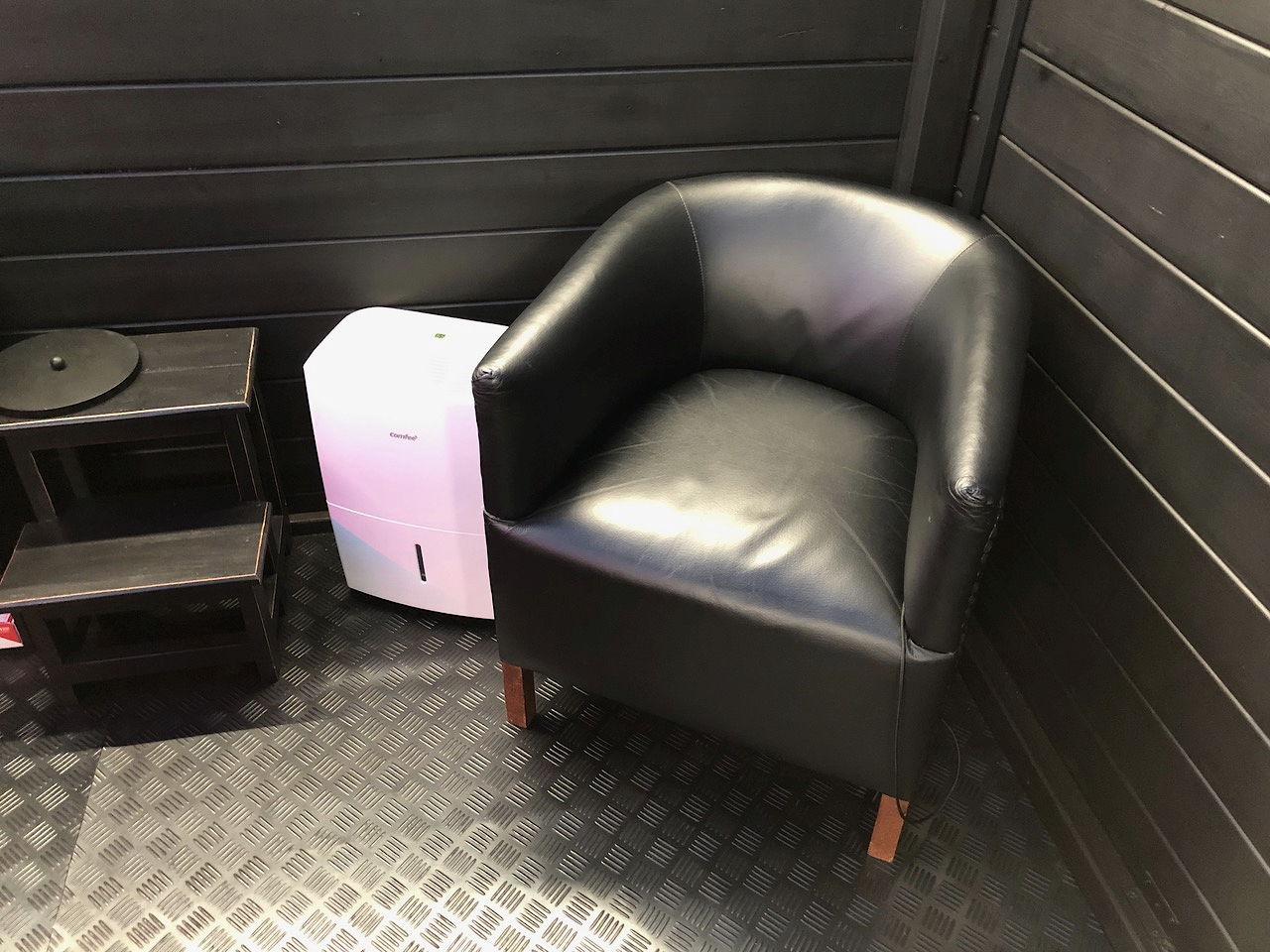 In the summer you may exceptionally sit outside. The floor was covered with black antistatic rubber mats.
In the summer you may exceptionally sit outside. The floor was covered with black antistatic rubber mats.
On the left, a commercial dehumidifier that controls humidity to 70% with the roof closed to protect technology and instruments from fogging and mold.
 The lower part of the huge steel column is mounted on a cylindrical concrete pillar with a diameter of one metre with a 3x3 metre base plate, which together weighs more than 4 tonnes. Very stable!
The lower part of the huge steel column is mounted on a cylindrical concrete pillar with a diameter of one metre with a 3x3 metre base plate, which together weighs more than 4 tonnes. Very stable!
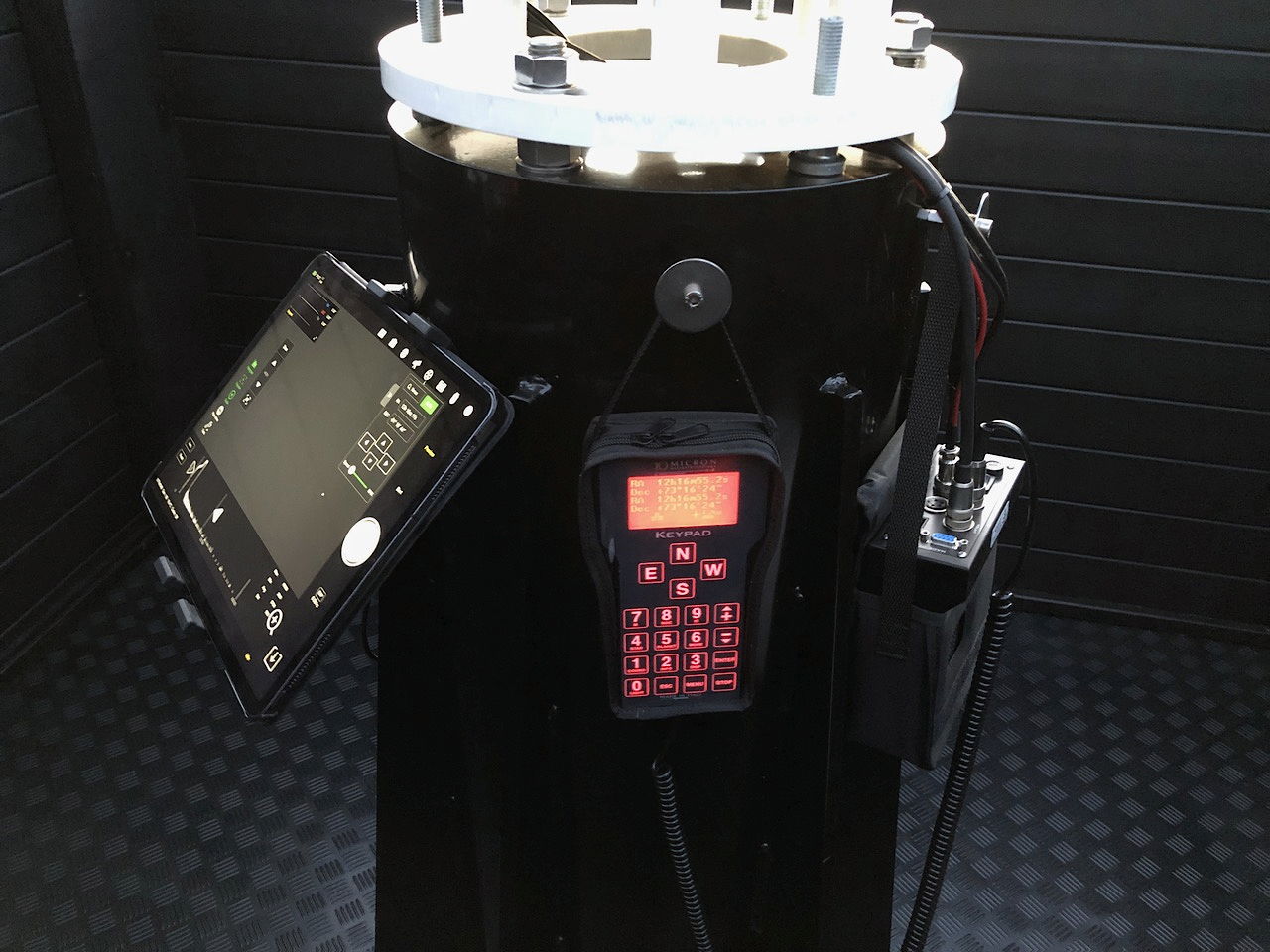 The upper part of the hefty steel column with the attached controls and the mounting electronics.
The upper part of the hefty steel column with the attached controls and the mounting electronics.
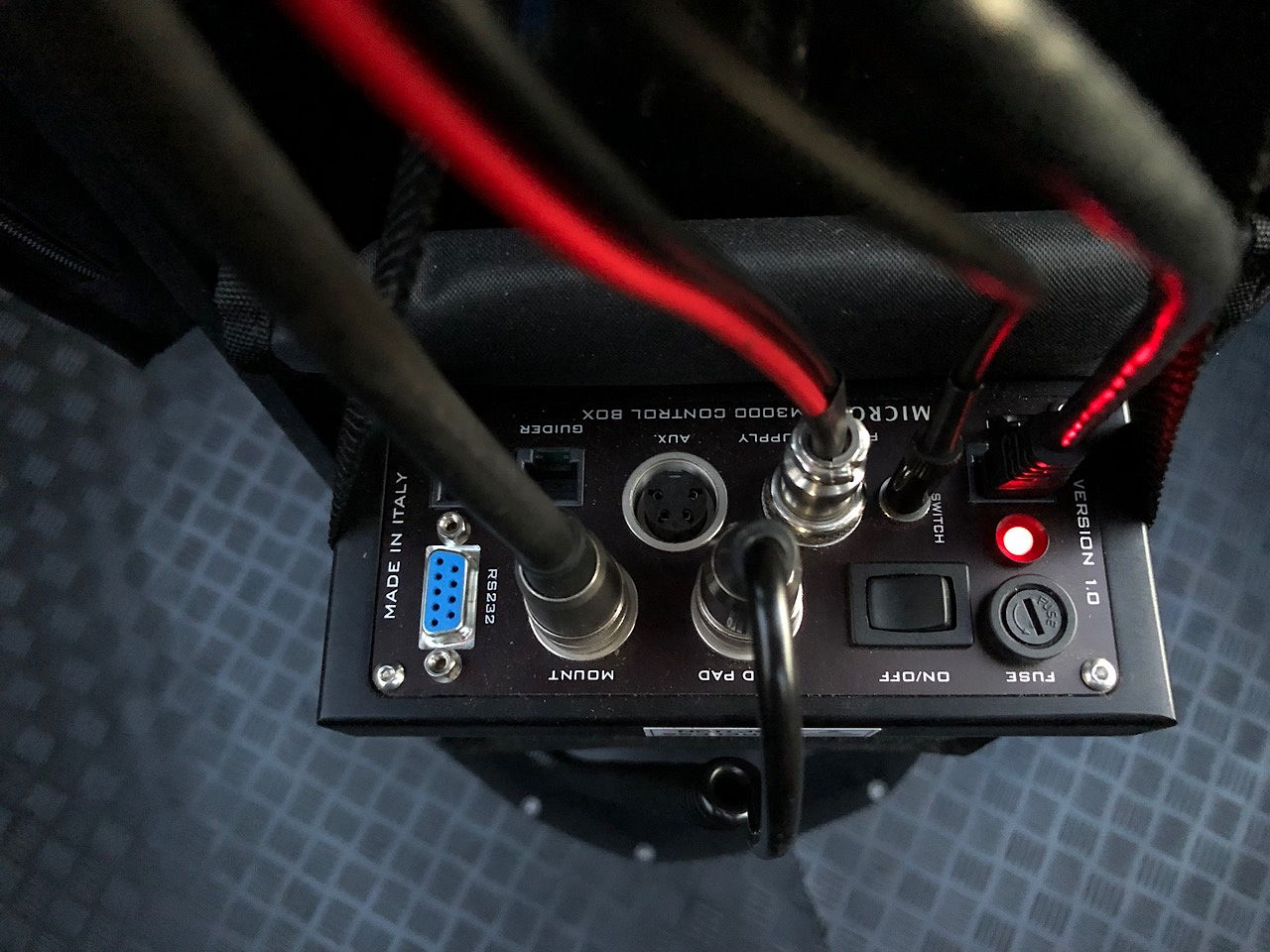 The electronics box for the mount is removable if you do not want to use the mount for a long time. It is connected to the inhouse Ethernet.
The electronics box for the mount is removable if you do not want to use the mount for a long time. It is connected to the inhouse Ethernet.
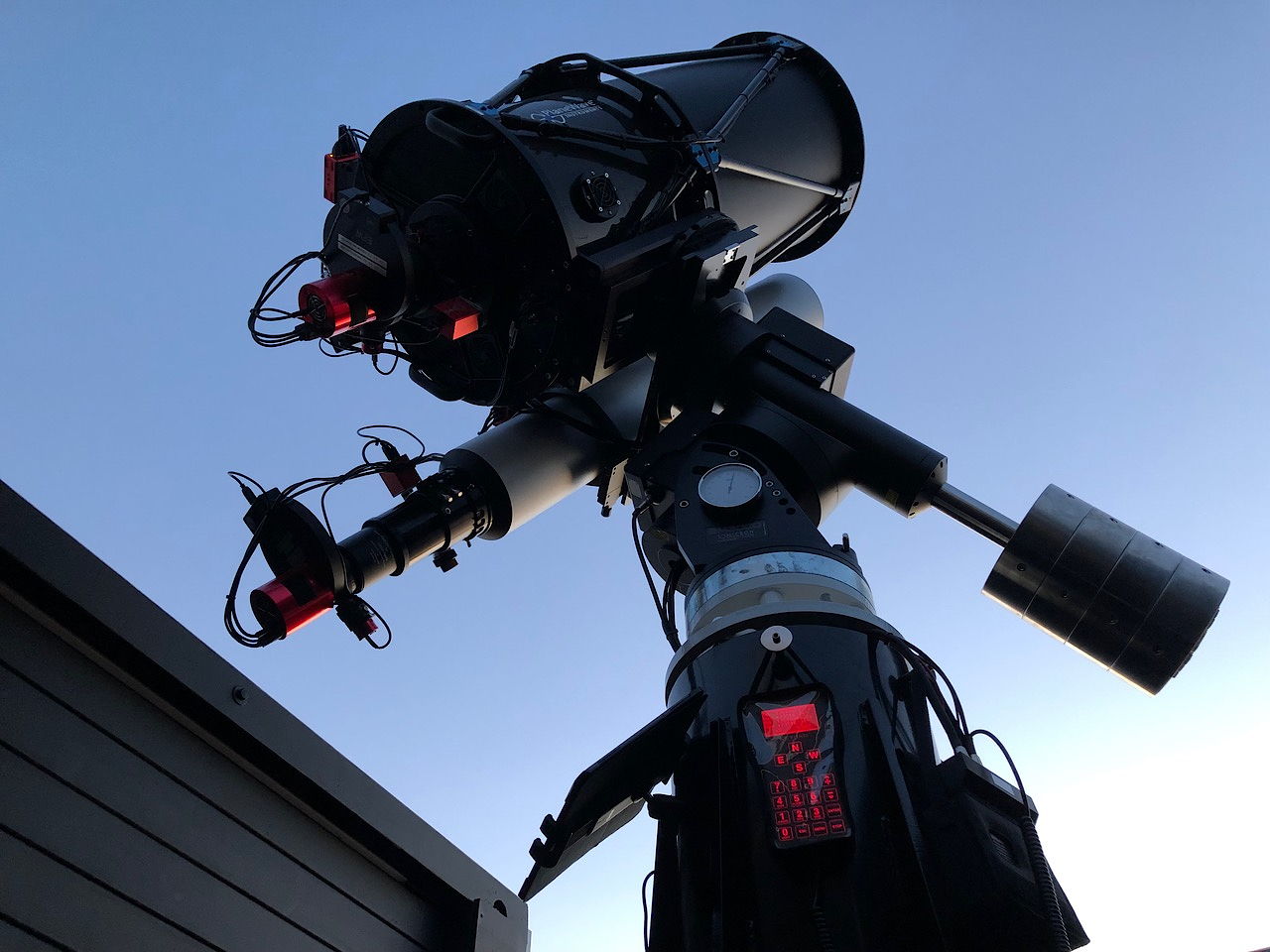 Commissioning of the mount after careful balancing in both axes in summer 2021.
Commissioning of the mount after careful balancing in both axes in summer 2021.
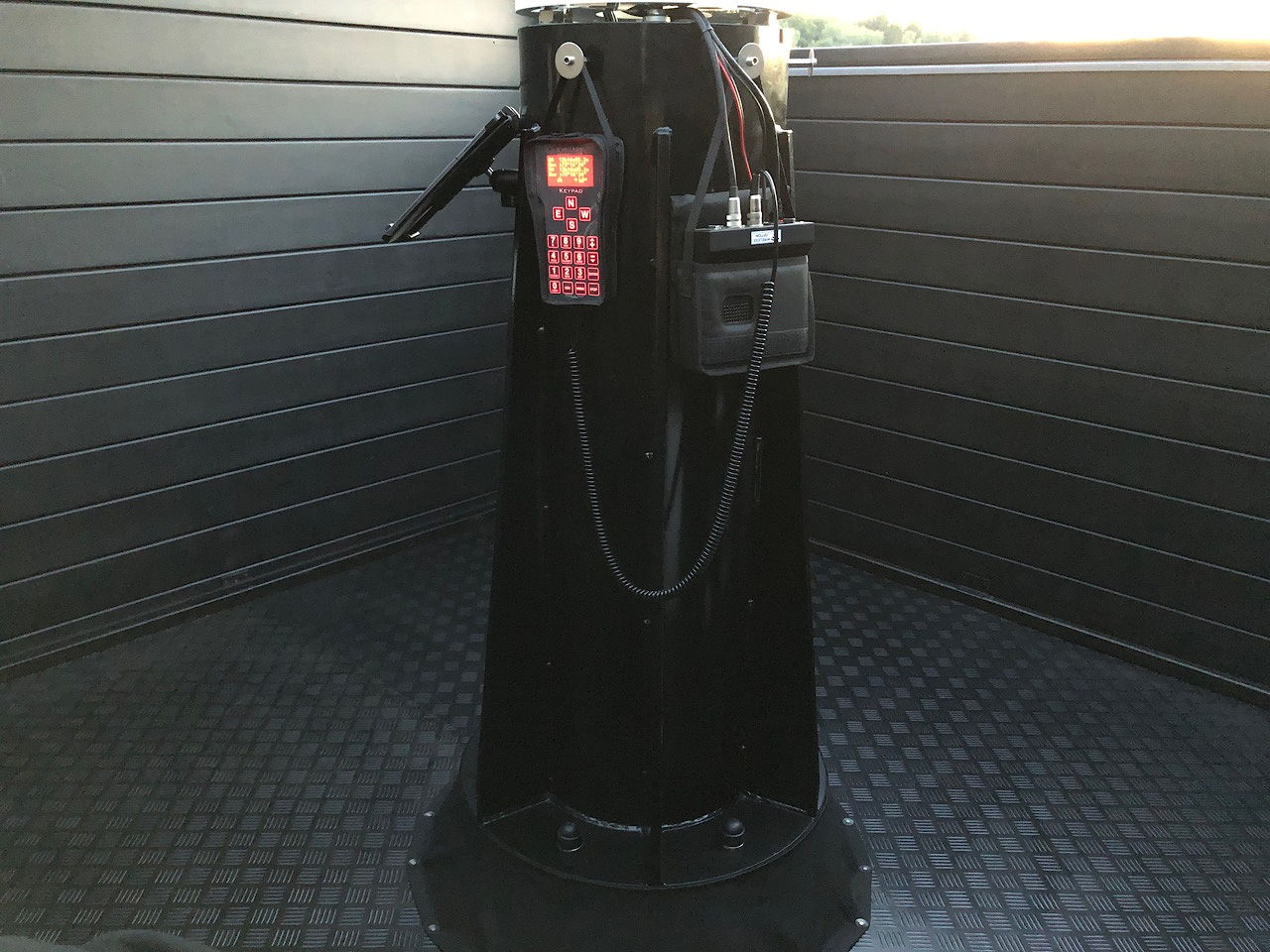 The hole in the observatory floor through which the upper part of the steel column passes was closed with an elastic fabric sleeve to prevent an insect paradise.
The hole in the observatory floor through which the upper part of the steel column passes was closed with an elastic fabric sleeve to prevent an insect paradise.
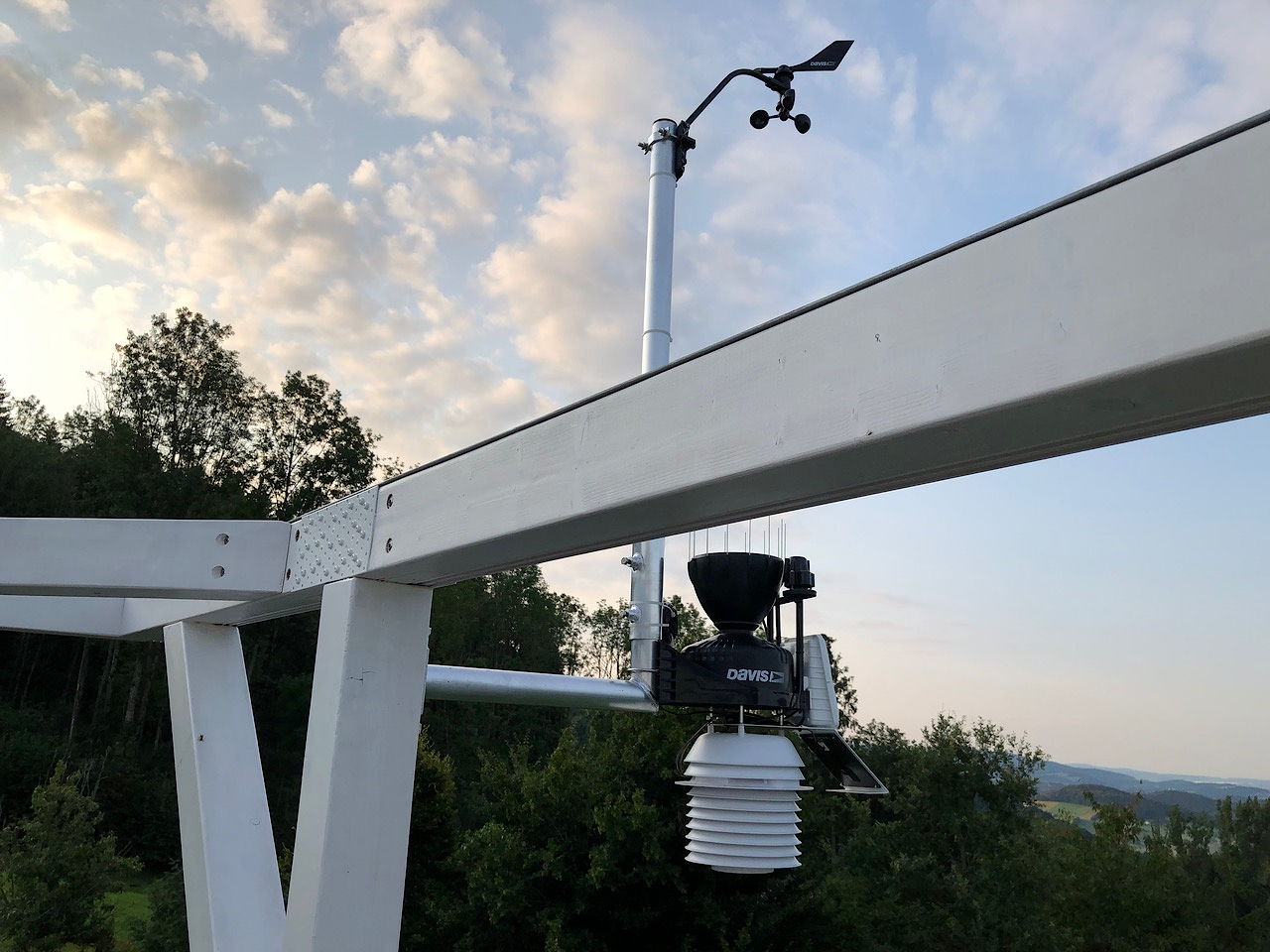 The Davis weather station on the boom delivers reliable weather parameters to the Internet, ready to be called up at any time and from everywhere.
The Davis weather station on the boom delivers reliable weather parameters to the Internet, ready to be called up at any time and from everywhere.
In addition, a sensor for the brightness of the night sky was installed. The mags data are also displayed below the Allsky camera image as a light curve.
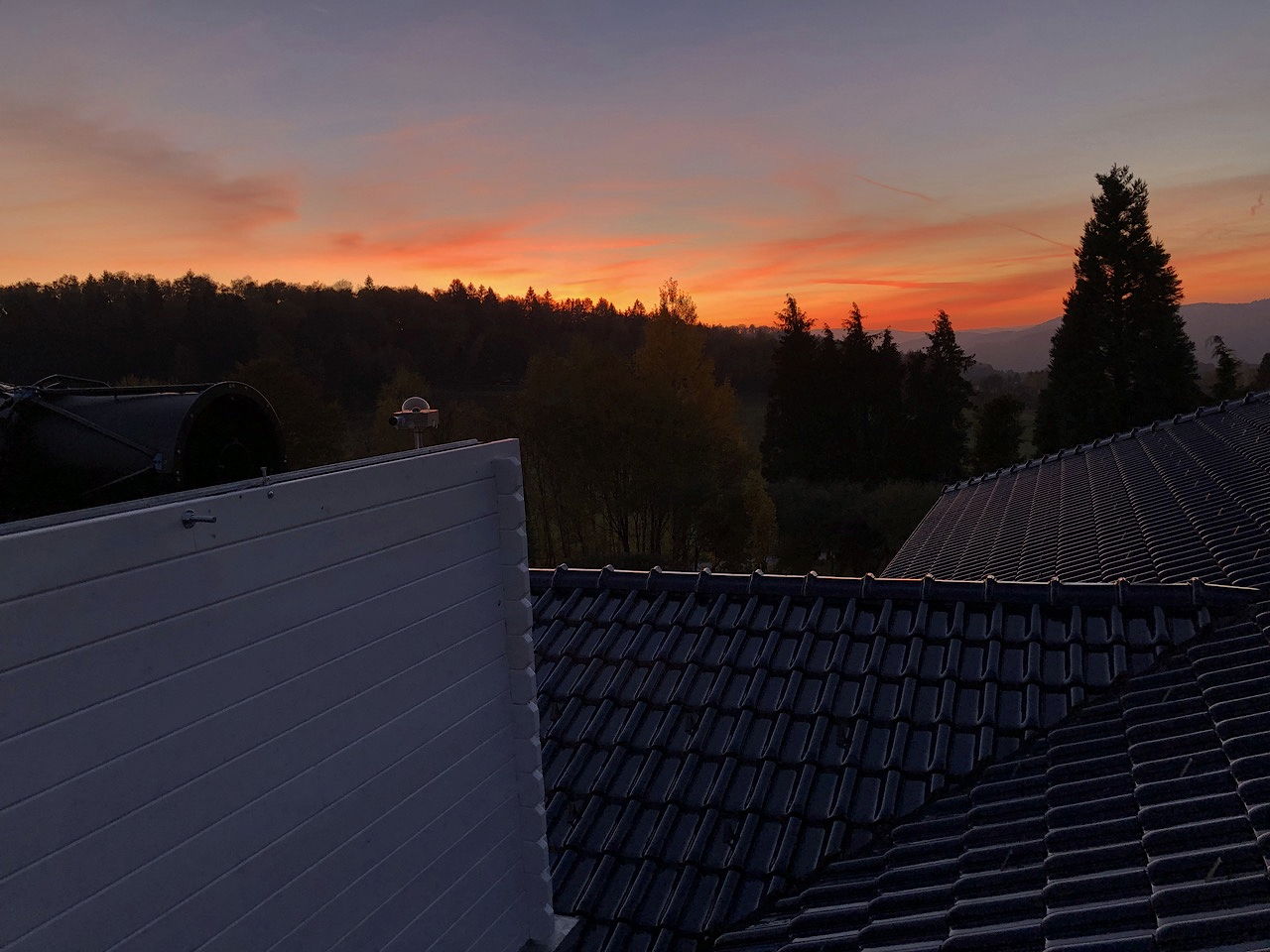 View into the sunset to the west before an astrophotographic observation night. In the background the Allsky camera can be seen.
View into the sunset to the west before an astrophotographic observation night. In the background the Allsky camera can be seen.
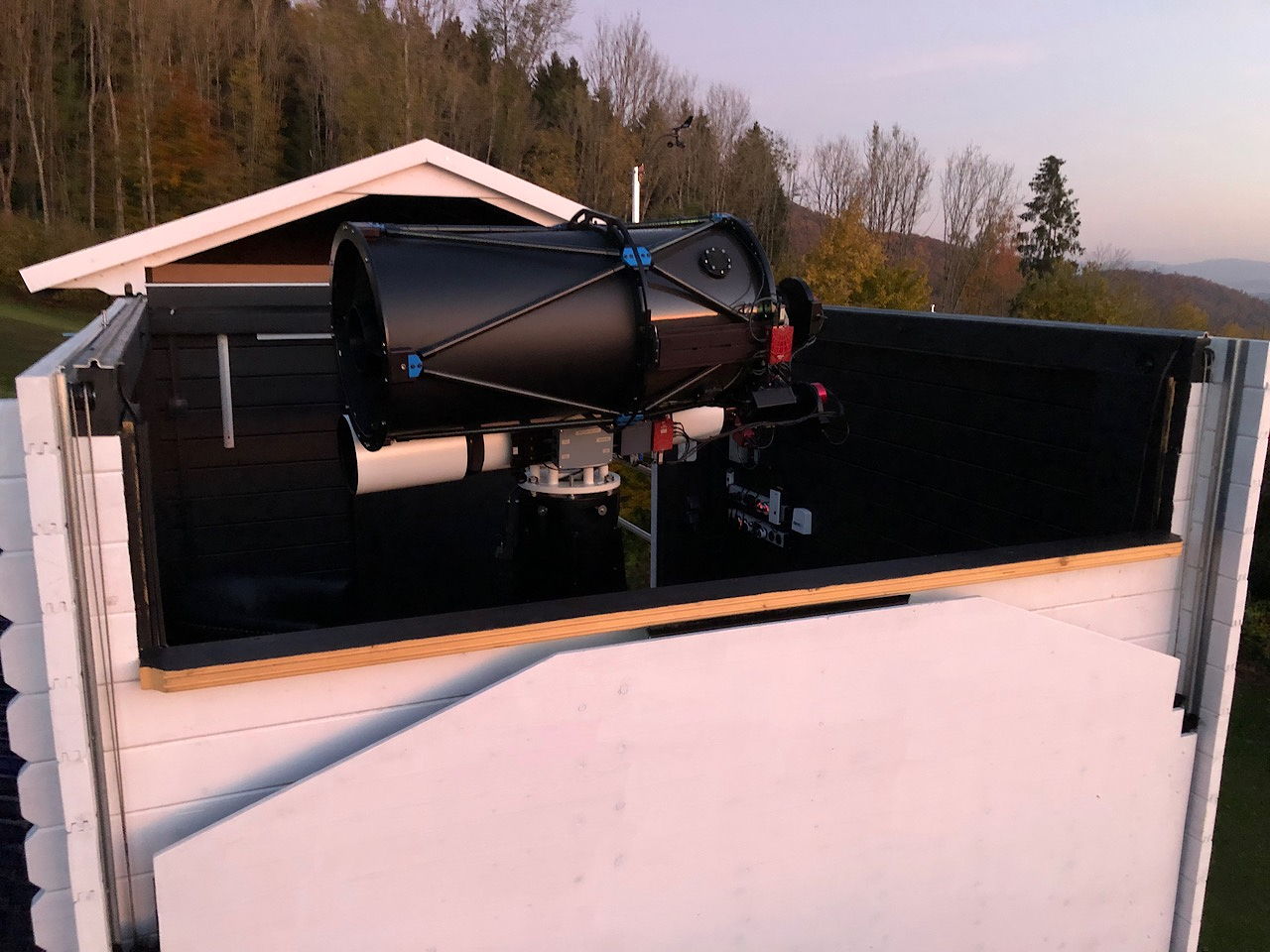 Before the roll-off roof can be closed, the mount must be moved to the park position as shown here. Otherwise, a safety contact blocks the roof motor.
Before the roll-off roof can be closed, the mount must be moved to the park position as shown here. Otherwise, a safety contact blocks the roof motor.
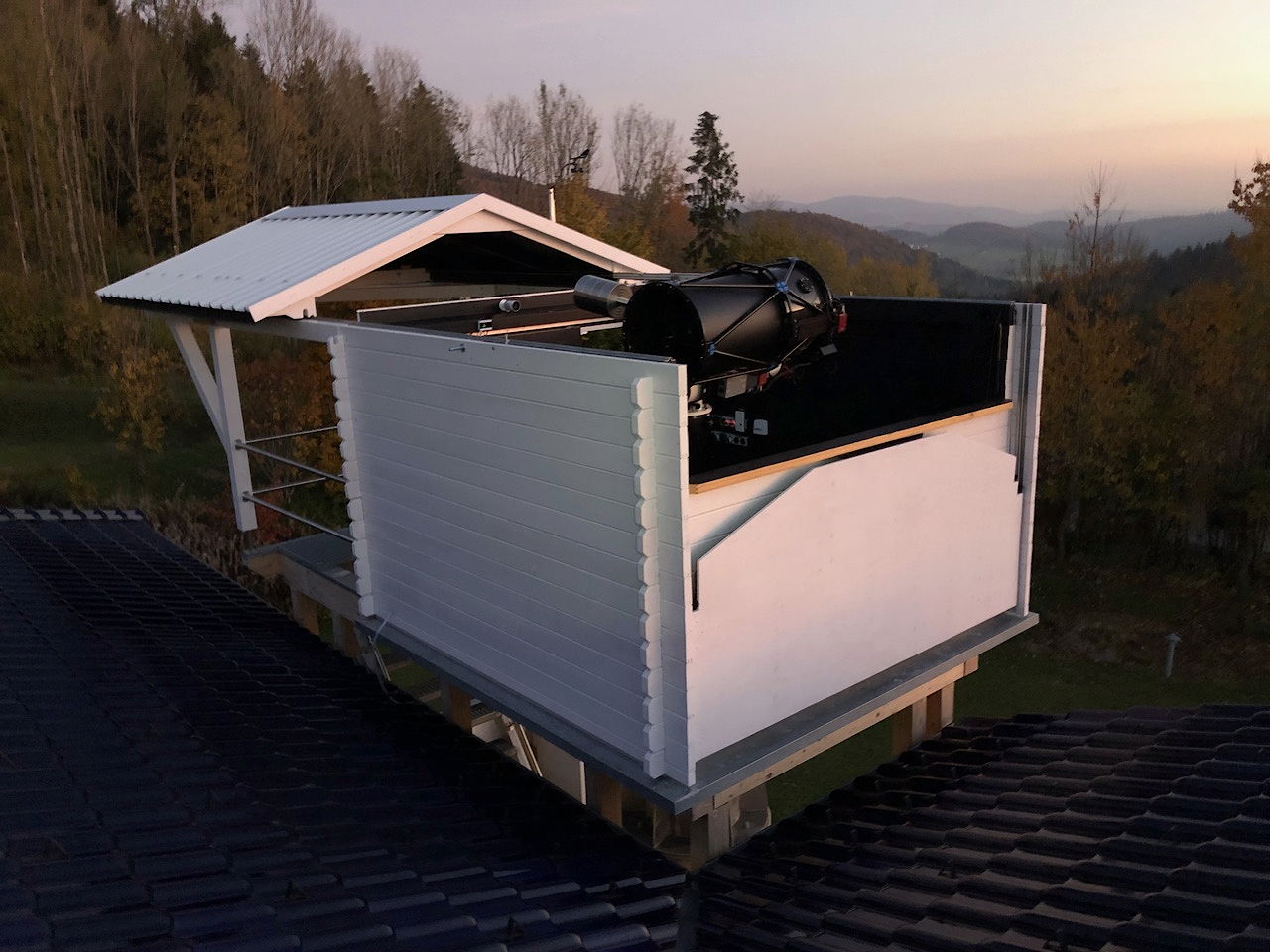 Here the view to the south. Three cardinal directions are completely free, to the east only from about 18° altitude because of the hill.
Here the view to the south. Three cardinal directions are completely free, to the east only from about 18° altitude because of the hill.
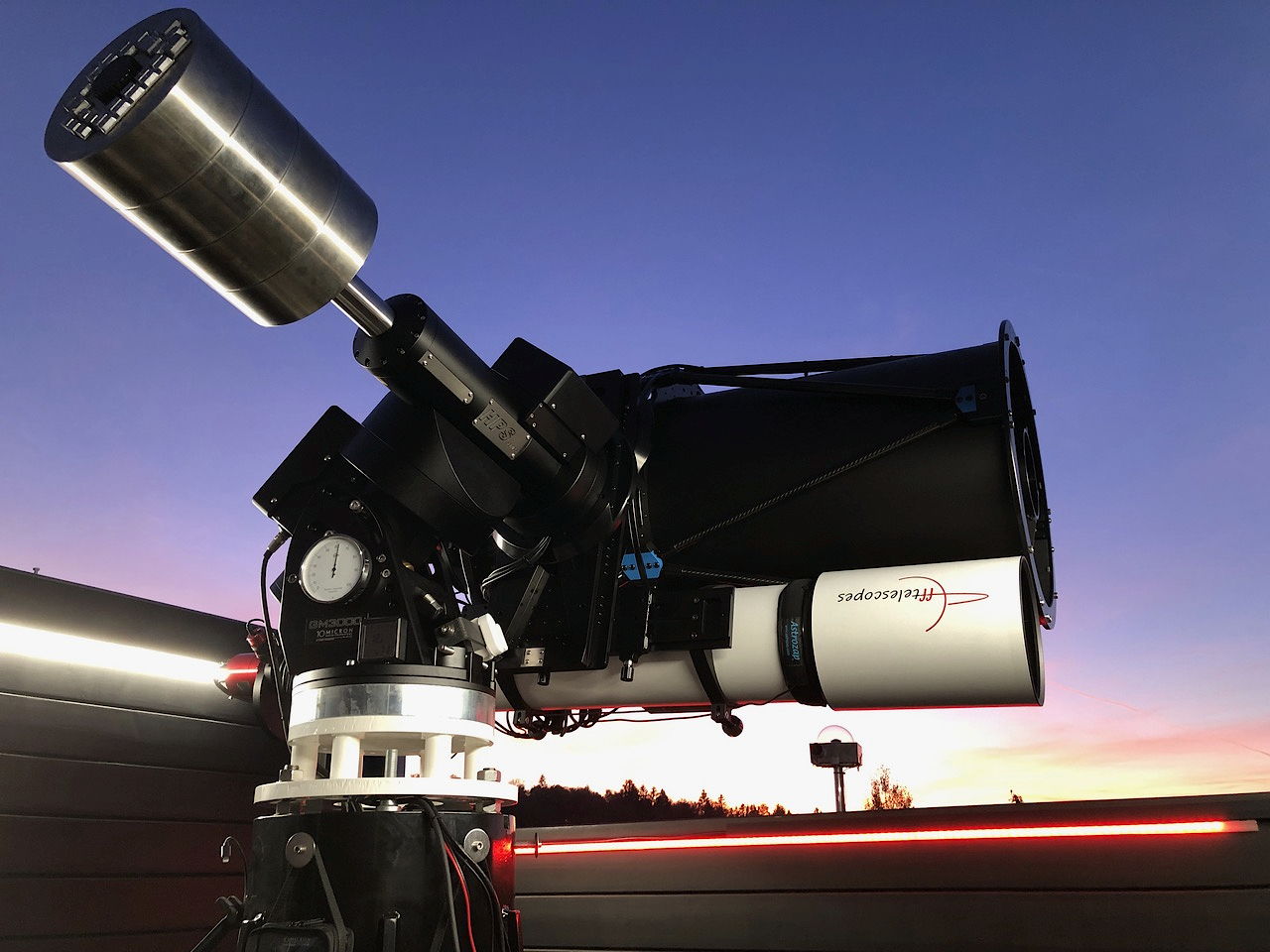 10Micron mounts allow programming of a special parking position, which in my case even looks just below the horizon, to allow the roof to close.
10Micron mounts allow programming of a special parking position, which in my case even looks just below the horizon, to allow the roof to close.
 A drone photo taken exactly from above. Here you can clearly see the space conditions with a 2.75 x 2.75m interior floor space.
A drone photo taken exactly from above. Here you can clearly see the space conditions with a 2.75 x 2.75m interior floor space.
The instruments do not come closer than about 20cm to the walls. There are also three IR surveillance cameras installed.
 The entrance door is designed as a magnetically closing sliding door. As decoration, all participating brands were allowed to immortalise themselves on signs.
The entrance door is designed as a magnetically closing sliding door. As decoration, all participating brands were allowed to immortalise themselves on signs.
The observatory was painted white on the outside to reduce heating in summer.
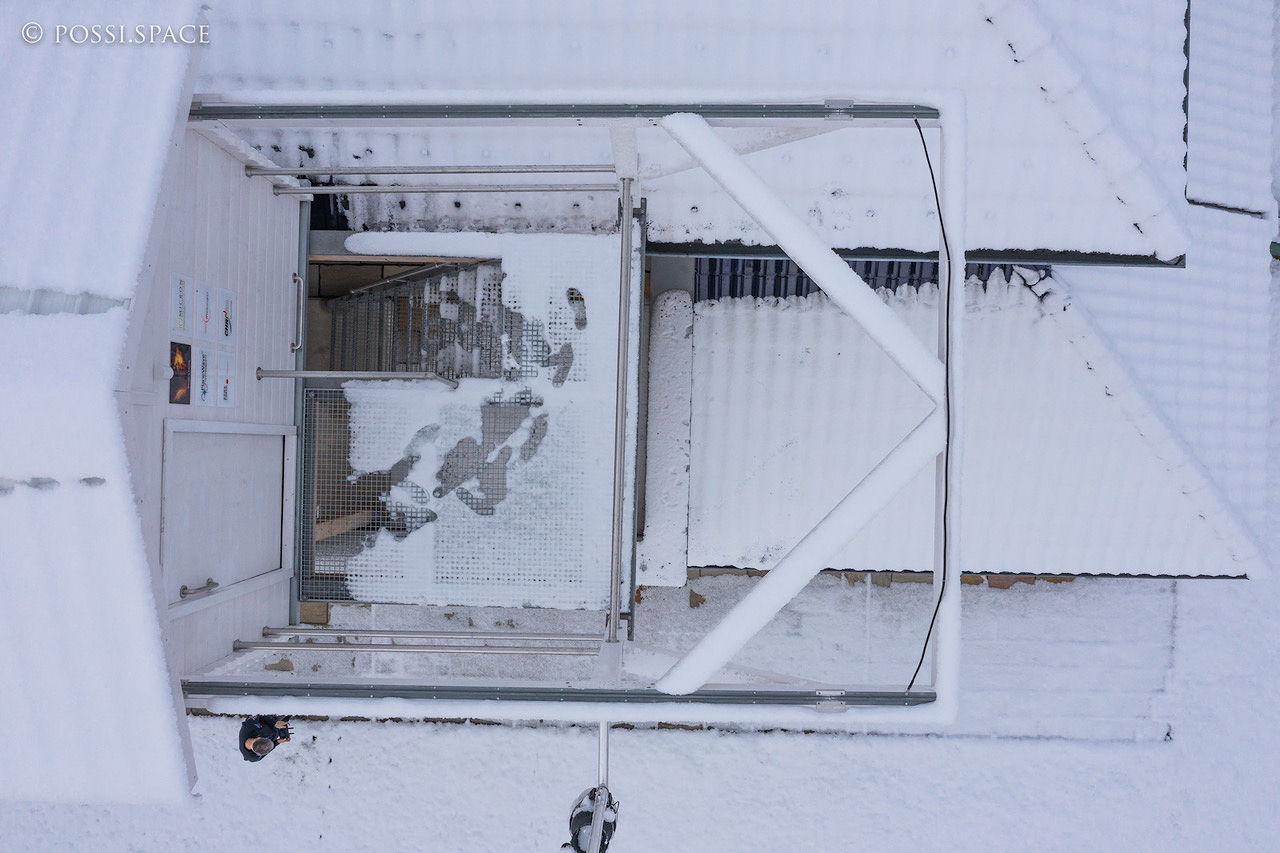 This is how it looked in mid-December 2021. I have constructed a low-voltage rail heater (4V/160A) that keeps the rails ice-free. But only a broom helps against massive snow.
This is how it looked in mid-December 2021. I have constructed a low-voltage rail heater (4V/160A) that keeps the rails ice-free. But only a broom helps against massive snow.